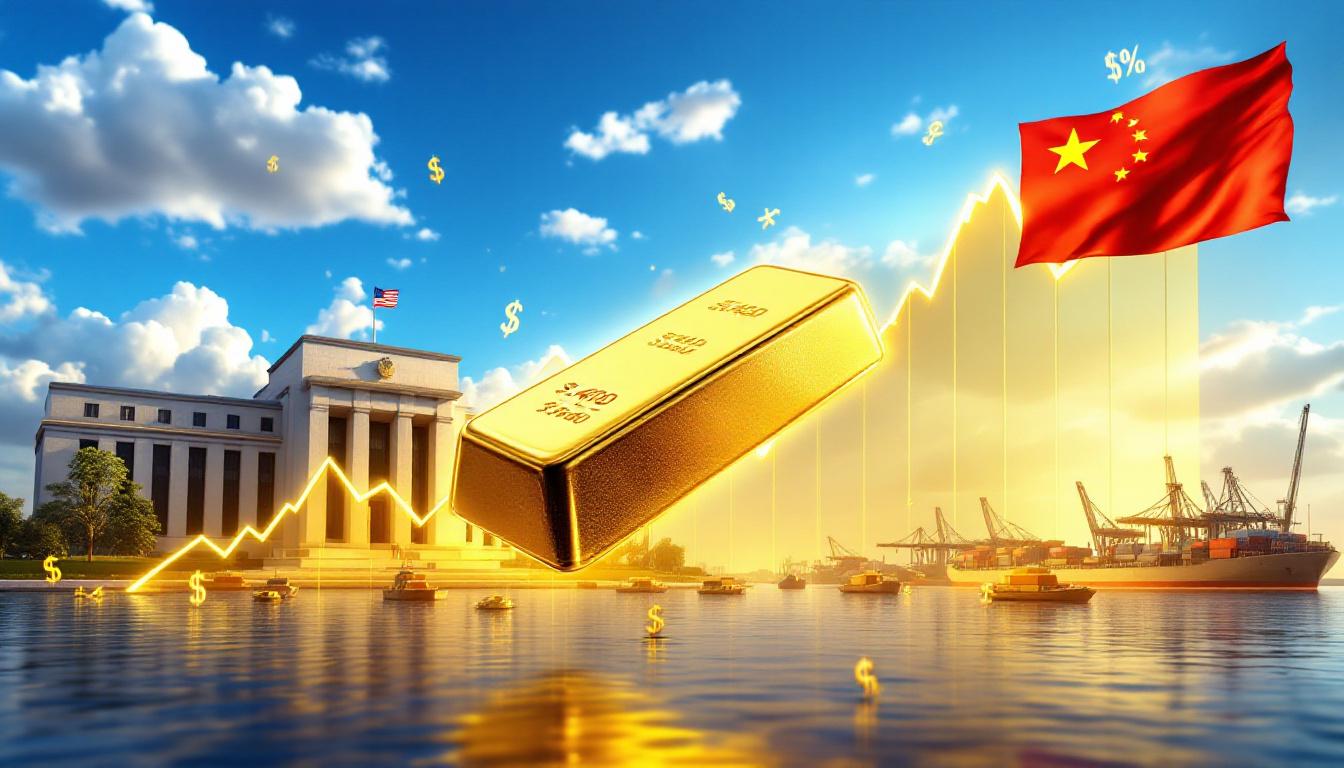What is the White House Mineral Independence Initiative?
The U.S. government has launched a comprehensive strategy to achieve "mineral independence" amid growing concerns about China's dominance in critical minerals supply chains. This initiative represents a significant shift in national security priorities, focusing on securing domestic sources of minerals essential for advanced technologies and defense systems.
On Thursday, July 24, 2025, Interior Secretary Doug Burgum issued the order establishing the White House Mineral Independence Initiative, marking a turning point in American resource policy.
"This initiative reflects our unwavering commitment to achieving mineral independence and ensuring that America leads the way in advanced technologies that power our future," stated Interior Secretary Burgum during the announcement ceremony.
Key Components of the Mineral Independence Strategy
The initiative includes several interconnected approaches:
- Mine Waste Recovery Program: Streamlining permits and funding for projects that extract valuable minerals from existing mine tailings and waste
- National Security Integration: Establishing dedicated positions within the National Security Council focused on mineral supply chains
- Domestic Production Support: Providing financial guarantees and price supports for U.S.-based rare earth producers
- International Partnership Development: Creating strategic alliances with mineral-rich nations outside China's sphere of influence
The Mine Waste Recovery Program specifically targets the extraction of rare earth elements, lithium, and cobalt from U.S. mine tailings, coal ash, and abandoned uranium mining halt. As part of this effort, the U.S. Geological Survey has been directed to map federal mine waste sites nationwide to identify the most promising recovery opportunities.
Economic and Environmental Benefits
The waste recovery program aims to transform environmental liabilities into economic assets. By extracting valuable minerals from millions of tons of mine tailings, coal ash, and abandoned uranium mines, the initiative addresses both resource security and environmental remediation simultaneously.
Industry players have already demonstrated interest in this approach. For example, Freeport-McMoRan plans to produce approximately 800 million pounds of copper annually by 2027 through leaching previously discarded ore in waste dumps. This production target highlights the significant economic potential of reprocessing mining waste that was once considered valueless.
The initiative creates a unique win-win scenario where environmental cleanup and resource security go hand-in-hand. By reprocessing waste, companies can extract valuable minerals while simultaneously reducing environmental hazards associated with abandoned mine sites—addressing two critical national priorities with a single approach through mine reclamation innovation.
How Does National Security Factor Into Mineral Strategy?
The New National Security Council Office
The administration has established a dedicated office within the National Security Council focused specifically on securing supply chains for minerals critical to advanced military technologies. This represents a significant elevation of mineral security as a national defense priority.
David Copley, a former mining executive and Navy Reserve intelligence officer, has been appointed to lead this new NSC office. This appointment signals the government's recognition that expertise in both mineral extraction and national security is essential for developing effective policies in this arena.
Strategic Minerals as Defense Assets
The appointment of mining industry experts to national security roles underscores how Washington increasingly views access to elements like nickel, cobalt, and rare earths as vital to national security. Recent disruptions in magnet shipments from China have forced emergency supply chain responses, highlighting the vulnerabilities in current systems.
These minerals form the foundation of technologies crucial for modern defense systems, including:
"Without secure access to these critical minerals, our advanced defense systems—from precision-guided munitions to next-generation aircraft—face substantial vulnerabilities. We cannot allow foreign suppliers to have a chokehold on America's national security infrastructure." — Senior Defense Department Official
The integration of mineral security into the national security apparatus represents a fundamental reconceptualization of what constitutes strategic resources in the 21st century. While oil dominated 20th-century geopolitics, rare earths and other critical minerals have emerged as the new strategic resources that nations must secure.
China's Strategic Leverage
Beijing's recent use of export restrictions as strategic leverage has accelerated U.S. concerns. China's near-total control of mineral processing gives it significant influence over global supply chains for technologies that underpin:
- Electric vehicle batteries
- Missile guidance systems
- Advanced defense electronics
- Renewable energy infrastructure
The strategic implications extend far beyond economics. When a single nation controls the processing of materials essential for both civilian and military technologies, it creates dependencies that can be exploited during geopolitical tensions—a vulnerability the U.S. mineral independence initiative aims to address.
What Support is Being Provided to Domestic Rare Earth Producers?
Pentagon's Price Guarantee Strategy
The Department of Defense has implemented unprecedented support measures for domestic rare earth producers, including:
- Price Floor Guarantees: Offering approximately $110 per kilogram for certain magnet-grade rare earth oxides
- Long-Term Purchase Commitments: Securing decade-long government procurement agreements
- Processing Capacity Investment: Supporting expansion of domestic refining capabilities
These price guarantees represent nearly double the current Chinese market levels, creating strong economic incentives for domestic production. The Pentagon recently announced a major deal with MP Materials Corp. (NYSE: MP), the only U.S. rare earth mining firm, to bolster domestic refining capacity.
The price guarantee strategy creates a stable market environment that allows companies to make long-term investments in production and processing infrastructure without fear of being undercut by Chinese suppliers—effectively creating a protected space for the U.S. rare earth industry to redevelop.
Market Response to Government Support
The market has responded positively to these initiatives. Companies like MP Materials Corp. have seen increased investor interest. International producers such as Lynas Rare Earths Ltd. have also benefited, with share prices rising following announcements of U.S. support programs.
Amanda Lacaze, CEO of Lynas Rare Earths, noted that "the move signals Washington's determination to break Beijing's dominance in rare metals supply chains and could spur a further rally in non-Chinese rare earth prices."
This market response demonstrates that government intervention can effectively reshape investment patterns in strategic industries. By providing guaranteed returns, the government has redirected capital flows toward domestic production capacity that might otherwise have been deemed too risky or unprofitable.
Production and Revenue Impacts
The government support has contributed to record production levels and higher selling prices. For example, Lynas Rare Earths reported:
- 42% surge in average selling price for rare earth products to A$60.2 per kg
- Quarterly revenue of approximately A$170.2 million (~$112 million), about 10% above analyst expectations
- Record production of neodymium and praseodymium (NdPr) at 2,080 tonnes
These impressive financial results demonstrate the economic viability of non-Chinese rare earth production when supported by appropriate government policies. The combination of price guarantees and purchase commitments has created a virtuous cycle of investment, production growth, and financial performance.
How Are Non-Chinese Companies Responding to Market Changes?
Vertical Integration and Supply Chain Development
Companies outside China are pursuing vertical integration strategies to reduce dependence on Chinese processing and manufacturing. Key developments include:
- Magnet Manufacturing Expansion: Companies like Lynas are partnering to develop magnet production facilities outside China
- Cross-Border Partnerships: Collaboration between companies in different countries to create China-free supply chains
- Production Capacity Increases: Record output of critical materials like NdPr oxide and first-time production of heavy rare earth oxides
The vertical integration approach represents a fundamental shift in how non-Chinese companies approach the rare earth market. Rather than focusing solely on mining or processing, companies are building complete supply chains that extend from mining through processing to end-product manufacturing—reducing vulnerability to Chinese choke points at any stage.
International Manufacturing Partnerships
Specific examples of these partnerships include Lynas Rare Earths' deal with JS Link Co. Ltd. of South Korea to develop a 3,000-tonne-per-year facility for Neodymium-Iron-Boron magnets near Lynas's plant in Kuantan, Malaysia. Under this arrangement:
- Lynas will supply both light and heavy rare earth feedstock
- JS Link will manufacture finished sintered magnets
- The facility will serve global EV demand without relying on Chinese magnet makers
This partnership model illustrates how companies are creating multinational alliances to build complete supply chains outside Chinese control. The Lynas-JS Link collaboration connects Australian mining expertise with South Korean manufacturing capabilities to create finished products essential for critical minerals transition technologies.
Beyond its core light rare earth business, Lynas has achieved a significant breakthrough with first-time production of heavy rare earth oxides like terbium. This diversification of product offerings strengthens the company's market position and further reduces global dependence on Chinese suppliers for these specialized materials.
What is China's Response to These Developments?
Export Restrictions and Quota Management
China has responded to U.S. initiatives with several strategic measures:
- Export Restrictions: Adding rare earth alloys and magnets to export control lists in April 2025
- Quota System Changes: Issuing mining and smelting quotas with increased secrecy
- Industry Consolidation: Reducing the number of companies eligible to receive quotas from six to just two state-run groups (China Rare Earth Group and Northern Rare Earth Group)
These measures represent a sophisticated response that leverages China's continued dominance in rare earth processing. Rather than engaging in a direct US‑China trade war, China has implemented targeted restrictions and structural changes that maintain its strategic leverage while minimizing global market disruption.
The quota system changes are particularly significant, as they centralize control under state-owned enterprises while increasing secrecy. Companies receiving 2025 quotas were instructed not to disclose figures for security reasons, making it difficult for other nations to accurately assess Chinese production capacity and export intentions.
Impact on Global Supply Chains
These measures have created significant disruptions in global supply chains:
- Sharp drops in magnet exports during restriction periods
- Production line pauses at certain U.S. and European automakers due to magnet shortages
- Price volatility in international markets
The supply chain disruptions reveal the extent of global dependence on Chinese rare earth products, particularly in finished forms like magnets. Even with increased mining capacity outside China, the manufacturing bottleneck for specialized components remains a critical vulnerability for industries ranging from automotive to defense.
Recent Trade Developments
After the initial shock of new export permit rules, some trade flows have begun to recover. Chinese rare earth magnet shipments to the United States soared 660% in June to 353 metric tons compared to the previous month, though this figure remains below historical levels.
Overall, China exported 3,188 tons of rare earth magnets worldwide in June, up 157% from May but still 38% lower than June 2024. This partial recovery suggests China may be calibrating its response to avoid forcing accelerated development of alternative supply chains while maintaining strategic leverage.
The fluctuating export volumes highlight the delicate balance China is trying to maintain—restricting supplies enough to signal its market power without triggering a complete overhaul of global supply chains that would permanently reduce its influence.
How Are Tech Billionaires Investing in Critical Minerals?
KoBold Metals' Strategic Investment in DRC Lithium
KoBold Metals, backed by prominent tech investors including Jeff Bezos and Bill Gates, has secured a significant agreement with the Democratic Republic of Congo (DRC) regarding the Manono lithium deposit—one of the world's largest known lithium resources.
This investment represents a convergence of tech industry capital with strategic mineral resources. The involvement of tech billionaires signals growing recognition that control of battery metals is essential for the future of electric vehicles, renewable energy storage, and other technologies central to their business interests.
Terms of the Agreement
The deal positions KoBold Metals as the Congolese government's preferred partner to:
- Resolve a long-running ownership dispute at the Manono deposit
- Apply for exploration licenses covering over 1,600 square kilometers by the July 31, 2025 deadline
- Deploy cutting-edge AI technology to locate additional mineral resources
- Accelerate development of this strategic lithium resource
The agreement follows the DRC government's 2023 revocation of rights previously held by Australian miner AVZ Minerals Ltd., which had been locked in legal disputes with other claimants. KoBold's entry offers a fresh start for the project with backing from influential investors and sophisticated technology.
The AI capabilities that KoBold brings to mineral exploration represent a significant technological advantage. By applying machine learning algorithms to geological data, the company can potentially identify high-grade deposits that traditional exploration methods might miss, maximizing the value extracted from the licensed areas.
Strategic Significance
This investment aligns with broader U.S. efforts to secure diversified sources of lithium and other battery metals outside China's sphere of influence. The involvement of high-profile tech investors signals growing private sector recognition of critical minerals as strategic assets.
The agreement follows recent diplomatic efforts in the region, including a U.S.-brokered agreement in eastern Congo that explicitly supports infrastructure development for mineral transport.
The White House mineral independence initiative and Bezos and Gates' lithium deal in the DRC represents a new model of resource development that combines:
- Private sector capital from tech industry leaders
- Advanced technologies not typically deployed in traditional mining
- Strategic alignment with U.S. government mineral security goals
- Partnership with resource-rich nations seeking technology transfer
This model could potentially reshape how critical mineral resources are developed globally, accelerating the transition from traditional extraction models to technology-enhanced resource development partnerships.
What International Partnerships Are Being Developed?
U.S.-Indonesia Strategic Trade Management
The United States is negotiating a strategic trade management pact with Indonesia—one of the world's top sources of nickel, tin, and copper. This arrangement aims to:
- Monitor exports of critical minerals with dual civilian and military applications
- Establish rules of origin and limits on re-export via third countries
- Potentially reduce tariffs on specific Indonesian-origin minerals that America cannot produce domestically
The negotiations have already yielded some concrete results, with the U.S. lowering tariffs on Indonesian goods to 19% from a threatened 32%. This tariff reduction signals America's willingness to offer meaningful trade concessions in exchange for mineral security arrangements.
Benefits for Both Nations
For Indonesia, which holds large reserves of rare earth elements and is the world's largest nickel producer, the partnership could bring:
- Increased investment in mining and processing infrastructure
- Protection from geopolitical crossfire in U.S.-China tensions
- Preferential access to U.S. markets for mineral exports
For the United States, the agreement represents another step toward building supply networks for materials needed in semiconductors, EV batteries, and defense hardware that don't rely on Chinese suppliers.
Airlangga Hartarto, Indonesia's chief economic minister, emphasized the mutual benefits: "Strategic trade management is important to ensure transparency… so that imports and exports of dual-function commodities with strategic value can be monitored." He further noted, "They (the U.S.) want to ensure these strategic components do not fall into the hands of certain parties, including for use in terrorism or other purposes."
The Lobito Corridor Initiative
The U.S. is also supporting the Lobito Corridor plan to develop transport links for Congolese minerals to Atlantic ports. This infrastructure project aims to:
- Create secure supply chains for critical minerals from central Africa
- Reduce the region's dependence on Chinese miners and traders
- Support economic development in mineral-rich African nations
The Lobito Corridor initiative demonstrates how mineral security strategies now extend beyond mining and processing to include transportation infrastructure. By supporting the development of alternative export routes, the U.S. is helping to ensure that increased African mineral production doesn't remain dependent on Chinese-controlled logistics networks.
These international partnerships illustrate the multifaceted approach required for the White House mineral independence initiative to succeed. Building complete supply chains requires not just domestic production but also strategic relationships with resource-rich nations that can provide materials that America cannot produce in sufficient quantities domestically.
What Are the Long-Term Implications for Global Mineral Markets?
Restructuring of Global Supply Chains
The combined effect of government initiatives, private sector investments, and international partnerships is likely to reshape global mineral supply chains over the coming decade. Key trends include:
- Diversification of Supply Sources: Reduced concentration of production and processing in China
- Premium Pricing for Non-Chinese Materials: Higher valuations for minerals sourced outside Chinese control
- Increased Investment in Processing Technology: Development of more efficient extraction and refining methods
- Greater Supply Chain Transparency: Enhanced tracking and certification of mineral origins
This restructuring represents the most significant shift in critical mineral supply chains since China achieved its dominant position in the 1990s and early 2000s. The emergence of multiple supply hubs with varying technological capabilities and cost structures will create a more complex but potentially more resilient global market.
Challenges and Uncertainties
Despite progress, significant challenges remain:
- Development Timelines: New mines and processing facilities typically require 5-10 years to reach full production
- Technical Expertise Gaps: China has developed specialized knowledge that will take time to replicate
- Environmental Considerations: Balancing resource extraction with sustainability goals
- Geopolitical Risks: Potential for trade disputes to disrupt new supply arrangements
"The greatest challenge in reshaping global mineral supply chains isn't finding the minerals—it's developing the processing expertise and infrastructure that China has spent decades perfecting. This knowledge gap can't be closed overnight, regardless of investment levels." — Mining Industry Analyst
The environmental challenges are particularly significant. While the
Want to Spot the Next Major Mineral Discovery?
Discover how significant mineral finds like those mentioned in the White House Mineral Independence Initiative can create substantial investment returns by exploring Discovery Alert's dedicated discoveries page. Our proprietary Discovery IQ model delivers real-time alerts on ASX mineral discoveries, giving you the market edge to capitalise on opportunities before they become mainstream news.




